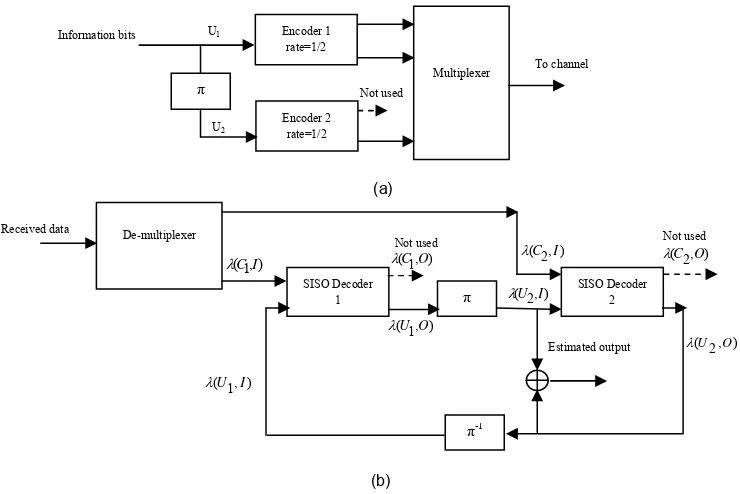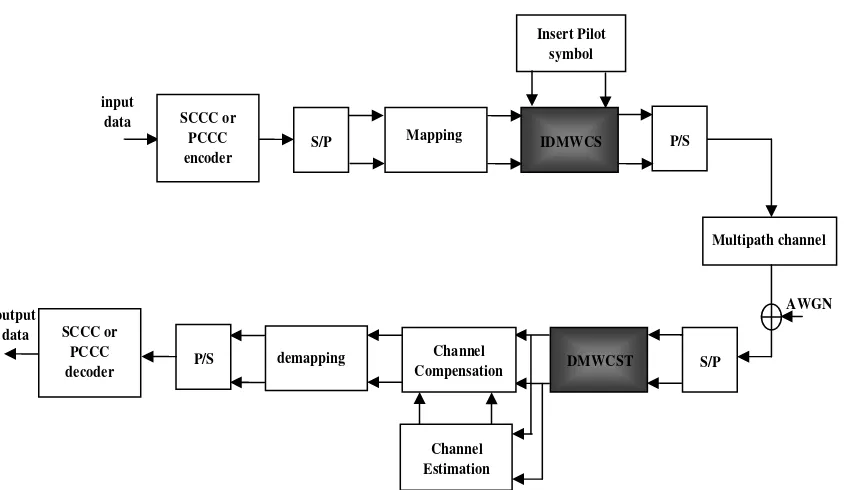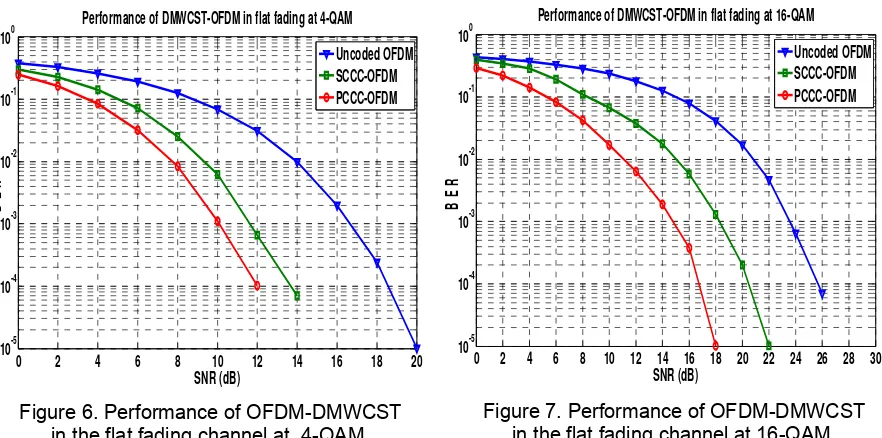DOI: 10.12928/TELKOMNIKA.v13i4.1846 1225
Enhancement the Performance of OFDM based on
Multiwavelets Using Turbo Codes
Sameer A Dawood1, F. Malek2, MS Anuar1, HA Rahim1 1
School of Computer and Communication Engineering, University Malaysia Perlis (UniMAP), Pauh Putra, 02600, Arau, Perlis, Malaysia
2
School of Electrical Systems Engineering, University Malaysia Perlis (UniMAP), Pauh Putra, 02600, Arau, Perlis, Malaysia
e-mail: [email protected]
Abstract
In wireless communication systems, the main challenge is to provide a high data rate and reliable transmission over a frequency selective fading channel. Orthogonal Frequency Division Multiplexing (OFDM) is a very attractive technique for high data rate transmission with better bandwidth efficiency. In this paper, the effectiveness of turbo codes is utilized to develop a new approach for an OFDM system based on a Discrete Multiwavelet Critical-Sampling Transform (OFDM-DMWCST). The use of turbo coding in an OFDM-DMWCST system is useful in providing the desired performance at higher data rates. Two types of turbo codes were used in this work, i.e., Parallel Concatenated Convolutional Codes (PCCCs) and Serial Concatenated Convolutional Codes (SCCCs). In both types, the decoding is performed by the iterative decoding algorithm based on the log-MAP (Maximum A Posteriori) algorithm. The simulation results showed that, the turbo-coded OFDM-DMWCST system achieves large coding gain with lower Bit-Error-Rate (BER), therefore, offering a higher data rate under different channel conditions. In addition, the PCCCs offer better performance than SCCCs.
Keywords: OFDM, multiwavelet transform, turbo codes, wireless channels, bit error rate
Copyright © 2015 Universitas Ahmad Dahlan. All rights reserved.
1. Introduction
The present mobile communication systems must provide high-quality communication and a high data rate for multimedia applications. One of the promising multicarrier modulation schemes to fulfill the high data rate requirement is Orthogonal Frequency Division Multiplexing (OFDM) [1]. OFDM is an efficient, high data rate, having advantages of high spectrum efficiency, simple and efficient implementation by using the Fast Fourier Transform (FFT), mitigation of Inter-Symbol Interference (ISI) by inserting a Cyclic Prefix (CP) and robustness to frequency selective fading channels transmission technique for wireless communication [2, 3]. Although the concept of CP traditionally has been associated with OFDM systems, however, the CP introduces a loss in transmission power and bandwidth [4].
Due to the disadvantage of OFDM system caused by using CP, an alternative method is to use of the Discrete Wavelet Transform (DWT) instead of FFT has been proposed recently [5-8]. By using the DWT, the spectral containment of the channels is better since they are not using CP.
Multiwavelets are a new development of the wavelet theory. It has two scaling and wavelet functions in each level, rather than one scaling function and one wavelet function that wavelet transform has. Multiwavelets are designed to possess symmetry, orthogonality and a higher order of approximation simultaneously, which are impossible for a scalar wavelet [9, 10].
high data rate transmission and in a frequency-selective fading channel, the BER performance of OFDM-DMWCST becomes constant after a certain Signal-to-Noise Ratio (SNR). This is due to the residual of ISI which is caused, because CP is not used in the proposed system.
One method suggested to improve the performance of a communication system is to use the channel coding (also called error correcting codes). Error correcting codes are a method of adding redundancy to information in a controlled manner in order to give the ability of the receiver to detect and correct the errors that occurred in transmission [12]. As a powerful coding technique, turbo codes are a prime candidate for wireless applications and being considered for future mobile radio communications [13, 14].
In this paper, two approach of turbo codes will be used to improve the performance of OFDM-DMWCST system, the first one is Parallel Concatenated Convolutional Codes (PCCCs) and the second one is Serial Concatenated Convolutional Codes (SCCCs). Further performance gains and higher spectral efficiency were made by combining turbo codes and DMWCST in the design of OFDM systems.
The rest of the paper is arranged as follows. Section 2 presents the turbo codes proposed in this work. Section 3 presents the proposed system. Section 4 discusses the simulation results, and section 5 presents our conclusions.
2. Turbo Codes
There are two main types of turbo codes, i.e., serial concatenation and parallel concatenation. The concepts of SCCCs and PCCCs used in this work are introduced in the following subsections.
2.1. Serial Concatenated Convolutional Codes (SCCCs)
Figure 1, shows the block diagram of an SCCC system. The outer and the inner codes are Convolutional Code (CC), and the inner code must be Recursive Systematic Convolutional (RSC) code.
In Figure 1a, a rate of k/n SCCC is obtained using an outer encoder of a rate k/l, and an inner encoder of a rate l/n. A random interleaver (π) permutes the output codewords of the outer code before passing them to the inner code. Rate 1/3 is obtained by using an outer of rate 1/2 and an inner of rate 2/3.
Figure 1b, shows the decoding process of SCCC, which was done by iterative decoding using a Soft-Input/Soft-Output (SISO) module based on the Log-MAP (Maximum A Posteriori) algorithm. The symbols λ(.,I) and λ(.,O) at the input and output ports of SISO refer to Log-Likelihood Ratio (LLR). The LLR of a binary bit z(-1,1) is defined as [15]:
( 1/ )
( ) ln
( 1/ )
z y
z
z y
(1)
where y is the noisy received codewords and is probability.
During the first iteration, λ(UI,I) is set to zero, since no prior information is available on the input information bits of the inner encoder. The extrinsic LLRs, λ(UI,O), are passed through
Figure 1. Block diagram of SCCC: (a) SCCC encoder, (b) SCCC decoder
2.2. Parallel Concatenated Convolutional Codes (PCCCs)
Figure 2a shows the block diagram of a PCCC encoder. There are two RSC encoders of rate 1/2 in parallel, separated by a pseudo-random interleaver. A natural rate for such a code is 1/3 (one systematic bit and two parity bits for one data bit). The multiplexer converts two or more parallel sequences to a single serial sequence.
Figure 2b, shows the decoding process of PCCC. The de-multiplexer block converts the serial data that are received to parallel data. During the first iteration,λ(U1,I) and λ(U2,I) are set
to zero. λ(U1,O) are passed through interleaver (π) to obtain λ(U2,I), while λ(U2,O) is
de-interleaved (π1) to obtain λ(U1,I) to start the second iteration. At the final iteration, λ(U2,I) and
λ(U2,O) will be added together, and a hard decision is made on the summation to obtain the
estimated information bits.
Figure 2. Block diagram of PCCC: (a) PCCC encoder, (b) PCCC decoder Not used
(a) Information bits Encoder 1
rate=1/2
SISO Inner SISO Outer
2.3. SISO Decoding Algorithm
The SISO module is a four-port device that accepts two input sequences and gives two output sequences at any time. The two input vectors of SISO at time t are λt(C,I), which is a
prior information LLR of a codeword and λt(U,I), which is a prior information LLR of information
word. While the two output vectors at time t are λt(C,O), which is the extrinsic information LLR of
a codeword and λt(U,O), which is the extrinsic information LLR of information word.
SISO Log-MAP decoder uses the max*( ) operation which is defined as [15]:
max* ( ) ln( e )aj
j
j
a
(2)The SISO Log-MAP algorithm requires a forward and backward recursion. The forward recursions of state s at time t (t=0, 1,..., 2m -1) are given by:
where: e describes the transition (edge) between states of the trellis at time instants t and t+1, sS(e) is the starting state of edge (e), sE(e) is the ending state of edge (e), u(e) is the input symbol of edge (e), c(e) is the output symbol of edge (e), k/n is the code rate, and m is the maximum number of stages (memory size) in the encoder.
The forward and backward recursions will be initialized as [15]:
Then, the two outputs of the SISO decoder at time t are defined as:
3. Proposed System
The block diagram in Figure 3, gives the proposed model for OFDM based on DMWCST system with turbo codes. Random binary data are generated at the transmitter. These data are encoded by turbo code (SCCC or PCCC) of rate 1/3 as presented in the previous section. The next step is Serial-to-Parallel (S/P) conversion, and it is conducted to form OFDM symbols and to map the bits to symbols. Then, the training sequence (pilot subcarriers) is inserted. The N-point Inverse DMWCST (IDMWCST) is applied to the signal to achieve the multicarrier modulation technique. Zeros are inserted in several bins of IDMWCST to reduce interference of the adjacent carriers. The data converted to a frame structure and sent to the receiver over the channel.
At the receiver side, the inverse operations are performed to recover the correct data stream. The received signal is converted to a parallel version via S/P conversion. Now, N-point DMWCST are performed to achieve the multicarrier demodulation technique, and the zero pads are removed. Then, the training sequence is utilized to estimate the channel frequency response (H(k)) as follows:
( )
( ) , 1, 2,...
( )
Yp k
H k k
Xp k
(9)
where Yp(k) represents the received pilot subcarriers, and Xp(k) is the transmitted pilot
subcarriers. Estimated data (X k( )) can be obtained with the following equation:
( ) 1( ). ( ), 1, 2,...
X k H k Y k k (10)
The output of the channel compensator passes through signal demapping, and it is decoded by the turbo code (SCCC or PCCC) decoder.
Figure 3. Block diagram of the turbo-coded OFDM based on DMWCST system
4. Simulation Results and Discussion
In this section, the BER performance of uncoded DMWCST and coded OFDM-DMWCST using SCCCs and PCCCs is compared for different channel conditions, including
output data
input data
Insert Pilot symbol
IDMWCS
Channel Estimation S/P
Multipath channel P/S
S/P DMWCST
Channel Compensation P/S
SCCC or PCCC encoder
demapping
Mapping
AWGN
0 2 4 6 8 10 12 14 16 18 10-5
10-4 10-3 10-2 10-1 100
Performance of DMWCST-OFDM in AWGN at 4-QAM
SNR (dB)
BE
R
Uncoded OFDM SCCC-OFDM PCCC-OFDM
0 2 4 6 8 10 12 14 16 18 20 22 24 26 10-5
10-4 10-3 10-2 10-1 100
Performance of DMWCST-OFDM in AWGN at 16-QAM
SNR (dB)
BE
R
Uncoded OFDM SCCC-OFDM PCCC-OFDM
Figure 5. Performance of OFDM-DMWCST in the AWGN channel at 16-QAM. Figure 4. Performance of OFDM-DMWCST
in the AWGN channel at 4-QAM.
AWGN, Rayleigh flat fading, and Rayleigh frequency selective fading. The performance of these systems was analyzed using MATLAB version 7.8. Table 1, shows the parameters and their values for the system used in the simulation.
Table 1. Simulation Parameters
Parameter Value
System bandwidth 10 MHz
Number of DMWCST points (N) 64 Number of useful data subcarriers 48
Modulation type 4-QAM, and 16-QAM
Turbo code rate 1/3
PCCC encoder generator Encoder 1: [1,5/7]octal, dfree=5
Encoder 2: [1,5/7]octal, dfree=5
SCCC encoder generator Outer: [7,5]octal, dfree=5
Inner: [1, 0,7/3; 0,1,2/3]octal, dfree=3
Number of decoding iteration 5
Figures 4, and 5, illustrate a comparison of PCCC-OFDM, SCCC-OFDM, and uncoded OFDM over an AWGN channel using 4-QAM, and 16-QAM, respectively. These figures show that the performance of the OFDM system was improved by using turbo codes. In addition, the performance of PCCC-OFDM was better than that of SCCC-OFDM. Figure 4 shows that, at a BER = 10-3, the SNR of the PCCC-OFDM outperformed both the SCCC-OFDM and uncoded OFDM by about 1.6 and 6.7 dB, respectively. Figure 5, shows that, for a BER = 10-3, the SNR of the PCCC-OFDM outperformed the SCCC-OFDM and uncoded OFDM by about 4.3 and 9 dB, respectively.
0 2 4 6 8 10 12 14 16 18 20
Performance of DMWCST-OFDM in flat fading at 4-QAM
SNR (dB)
Figure 6. Performance of OFDM-DMWCST in the flat fading channel at 4-QAM.
0 2 4 6 8 10 12 14 16 18 20 22 24 26 28 30
Performance of DMWCST-OFDM in flat fading at 16-QAM
SNR (dB)
Figure 7. Performance of OFDM-DMWCST in the flat fading channel at 16-QAM.
0 2 4 6 8 10 12 14 16 18 20 22 24 26
Performance of DMWCST-OFDM in frequency selective fading at 4-QAM
SNR (dB)
Figure 8. Performance of OFDM-DMWCST in the selective fading channel at 4-QAM.
0 2 4 6 8 10 12 14 16 18 20 22 24 26 28 30 32 34 36 38 40
Performance of DMWCST-OFDM in frequency selective fading at 16-QAM
SNR (dB)
Figure 9. Performance of OFDM-DMWCST in the selective fading channel at 16-QAM. Figures 8, and 9, compare the performance of the three systems in a frequency-selective Rayleigh fading channel using 4-QAM and 16-QAM, respectively. Two paths were selected, the second path had a gain of −10 dB and a delay of eight samples. Obviously, the coded system was more robust in the frequency-selective fading channel than the uncoded OFDM. Also, PCCC-OFDM was better than SCCC-OFDM.
As shown in Figure 8, a BER = 10-3 resulted in a 7.3 dB improvement for PCCC-OFDM and 5.8 dB improvement for SCCC-OFDM compared with the uncoded system.
Figure 9 shows that, the BER became constant at 8.6*10-3 after SNR of approximately 36 dB in the uncoded OFDM, since no CP existed in the case of OFDM-DMWCST system; hence, ISI occurred and resulted in the loss of orthogonality between subcarriers and the occurrence of ICI. Turbo codes can eliminate the residual ISI and ICI, therefore, offering better performance in this channel. Also, the performance of OFDM-DMWCST with the PCCC coding scheme was better than that with the SCCC coding scheme. The figure shows that, the PCCC-OFDM system had a BER of 10-2 at SNR = 14 dB. SCCC-OFDM had the same BER at SNR = 18.8 dB, and uncoded OFDM had the same BER at SNR = 34 dB.
5. Conclusion
In this work, turbo codes are proposed for the OFDM-DMWCST system to achieve higher performance and robustness against wireless communication channel. The performance analysis of the proposed system was evaluated by simulations in different channels, including AWGN, Rayleigh flat fading, and Rayleigh frequency selective fading. The simulation results indicated that the use of turbo codes with the OFDM-DMWCST system can eliminate the residual ISI, therefore, offering a higher data rate in wireless communication. Also, the PCCCs system gives better BER performance at low SNR values than the SCCCs system in all of the channels. The good performance of the PCCCs system can be explained by its better burst error correction capability inside codeword's than the SCCCs system. Also, the PCCCs system provided good final estimation due to addition operation of two estimations taken from two SISO decoders in the receiver designed for the parallel group of two identical convolutional encoders.
References
[1] Goel A, Garg MK. Comparative performance evaluation of convolutionally coded and LDPC coded OFDM system over AWGN and SUI-5 fading channel. 3rd International Conference on Computer and Communication Technology (ICCCT). Allahabad. 2012; 250-254.
[2] Singh S, Ram H, Gill SS. Performance Evaluation of Channel Estimation in OFDM System for Different QAM and PSK Modulations. IAES, International Journal of Electrical and Computer Engineering (IJECE). 2011; 1: 140-150.
[3] Mei H, Sun H, En C, Kuai X, Xu X. Joint Interference Mitigation with Channel Estimated in Underwater Acoustic System. TELKOMNIKA Indonesian Journal of Electrical Engineering. 2013; 11(12): 7423-7430.
[4] Borra SK, Chaparala SK. Performance evaluation of OFDM system with Rayleigh, Rician and AWGN channels. International Journal of Emerging Technology and Advanced Engineering. 2013; 3: 678-682.
[5] Saad W, El Fishawy N, El-Rabaie S, Shokair M. An efficient technique for OFDM system using discrete wavelet transform. Advances in Grid and Pervasive Computing, Springer. 2010; 533-541. [6] Gupta MK, Tiwari S. Performance evaluation of conventional and wavelet based OFDM system.
AEU-International Journal of Electronics and Communications. 2013; 67: 348-354.
[7] Anuradha, Kumar N. BER analysis of conventional and wavelet based OFDM in LTE using different modulation techniques. in Proceedings of Engineering and Computational Sciences (RAECS), Chandigarh. 2014; 1-4.
[8] Harbi YJ, Burr AG. Comparison of Discrete Wavelet and FFT-OFDM under Different Channel Conditions. PGNet, 2014.
[9] Strela V, Heller PN, Strang G, Topiwala P, Heil C. The application of multiwavelet filter banks to image processing. IEEE Transactions on Image Processing. 1999; 8: 548-563.
[10] Martin MB, Bell AE. New image compression techniques using multiwavelets and multiwavelet packets. IEEE Transactions on Image Processing. 2001; 10: 500-510.
[11] Dawood AS, Malek F, Anuar MS, Hadi QS. Performance comparison of OFDM system based on DMWTCS, DWT, and FFT using QAM modulation technique. ARPN Journal of Engineering and Applied Sciences. 2014; 9: 2823- 2830.
[12] Moreira JC, Farrell PG. Essentials of error-control coding. England: John Wiley & Sons. 2006. [13] Sklar B. Digital Communications:Fundamentals and Applications. Second Edition. Prentice Hall, NJ.
2001.
[14] Nikopour H, Khandani AK, Jamali SH. Turbo-coded OFDM transmission over a nonlinear channel.
IEEE Transactions on Vehicular Technology. 2005; 54(4): 1361-1371.



